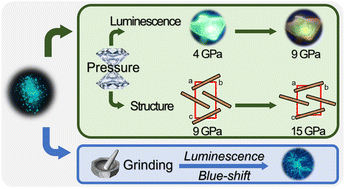Multiple responses of 1,6-diphenyl-1,3,5-hexatriene to mechanical stimulation: emission enhancement, piezochromism and negative linear compressibility†
Abstract
The properties of mechanoresponsive materials are mainly affected by intermolecular interaction, in which anisotropic grinding and hydrostatic high-pressure compression are the powerful tools used for modulation. Upon applying high pressure to 1,6-diphenyl-1,3,5-hexatriene (DPH), the reduced molecular symmetry results in the originally forbidden S0 → S1 transition to become allowed that then leads to a 13-times emission enhancement, and π–π interactions result in piezochromism (red-shifted up to 100 nm). With increasing pressure, high-pressure-stiffened H⋯C/C⋯H and H⋯H interactions enable the DPH molecules to generate a NLC mechanical response (9–15 GPa) with Kb = −5.8764 TPa−1 along the b-axis. As a contrast, upon destroying the intermolecular interactions by grinding, the DPH luminescence blue-shifts from cyan to blue. Based on this research, we investigate a new pressure-induced emission enhancement (PIEE) mechanism and enabled NLC phenomena by controlling weak intermolecular interactions. In-depth research of the evolution of intermolecular interactions has important reference value for developing new fluorescence materials and structural materials.



 Please wait while we load your content...
Please wait while we load your content...